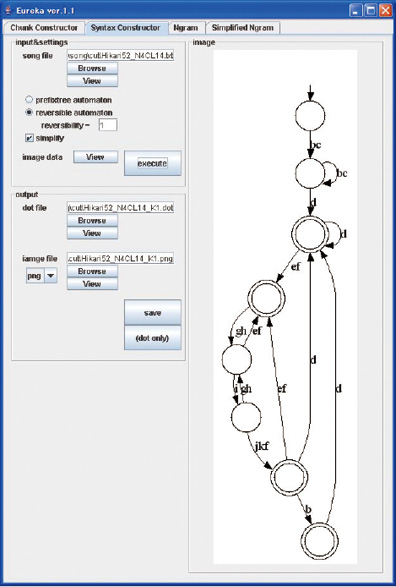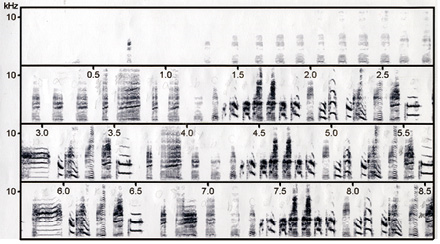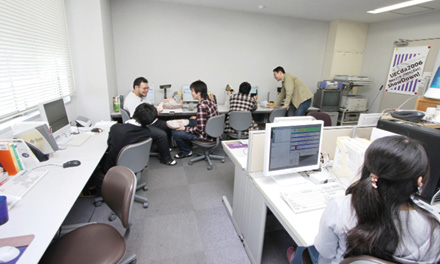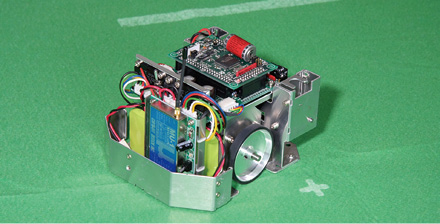
As of August, 2015
| Faculty/Department | Department of Informatics Graduate School of Informatics and Engineering |


|
| Members | Tetsuro Nishino, Professor Mitsuo Wakatsuki, Assistant professor |
|
| Affiliations | Information Processing Society of Japan, the Japanese Society for Artificial Intelligence, Institute of Electronics, Information and Communication Engineers, the Mathematical Society of Japan, Association for Computing Machinery (ACM), European Association for Theoretical Computer Science (EATCS), Institute of Electrical and Electronics Engineers (IEEE) | |
Computer science, artificial intelligence (AI), game informatics, application of quantum computer theory, conditioned reflex robot, internal clock (neural clock), analysis of language acquisition functions, general-purpose computing on graphics processing units(GPGPU), natural language processing
Our laboratory is active in the area of research to reproduce the motions of the human body and human brain functions on a computer. Broadly speaking, this means we work in the field of artificial intelligence (AI). The main focus of current AIstudies is on exploring the mechanisms of artificially-designed intelligent units and the associated software.
Some of the general trends in current computer science research involve developing computers that are more human-like and more intelligent, and capable of high-speed computing. With respect to intelligent computers, the tremendous progress in brain science studies over recent years has provided valuable feedback to those working in this field. In the area of high-speed computing, scientists are now exploring the possibilities of quantum computers.
Computers are founded on mathematics. Nevertheless, Professor Nishino believes computer science should focus not just on physics and brain science, but phenomena that more closely reflect real-life human activities, such as economics and game theory. He sees this is as the most promising approach to creating a totally new mechanism for information processing.
The ultimate goal of research at our laboratory is to reproduce in detail the intelligent everyday human activity.
Professor Nishino is currently working on multiple joint research projects, including investigating the mechanism of the brain, focusing especially on conditioned reflexes, through various experiments. While bipedal walking robots have been around for some time, there has yet to be a robot capable of skipping. This is because skipping motion is, in a sense, a type conditioned reflex, and conditioned reflexes entail learning. In the example of the skipping motion, robots must learn timing. (Humans are equipped with an internal clock to adjust timing.) Our present experiment involves designing a network of circuits, called a neural network, capable of simulating the human conditioned reflex system, then implementing the network in a robot to give it the capacity to learn conditioned-reflex-type actions. If successful, we should in the near future be able to create robots capable of controlling artificial muscles and performing intelligent actions humans can perform without thinking.
Our laboratory provides an environment for stimulating and challenging study of both humans and computers. For example, we host the “Computer Daihinmin Championship,” following in the footsteps of the Robot Contest, creating an enjoyable experience for students as they master the essentials of information science. We issue a call for computer programs for the card game Daihinmin across Japan; the entries submitted play against one another to determine the best program. In 2010, we were awarded the Prizes for Science and Technology (Public Understanding Promotion Category) of the Commendation for Science and Technology by the Minister of Education, Culture, Sports, Science and Technology.
We have also undertaken joint studies with RIKEN, Japan to analyze the song of the Bengalese Finch. The song of the Bengalese Finch varies from bird to bird, and with a distinct syntax for each individual. If we can clarify the learning process of a Bengalese Finch as it acquires its own distinctive song, perhaps we can identify the key to understanding language acquisition in human babies.
Our greatest advantage is that we can pursue studies in the most advanced fields in information processing and computing while incorporating the latest achievements in other advanced fields of study.
We know now that the Bengalese Finch, introduced above in “Advantages,” perfect their songs by listening to themselves sing and modifying their song. One of our long-term goals is to gain an understanding of the process of language evolution by studying this process.
If we can find a way to apply this mechanism to computers, it may be possible to create computers capable of learning words and language. We believe we may eventually be able to create a computer capable of comprehending the speech spoken by speech-impaired individuals.
In the sphere of high-speed computer research, quantum computers may take years to realize. In the meantime, we are applying the principles of quantum computers to information processing to create new encryption schemes, software for image compression, and other applications.

Recent years have seen dramatic improvements in the power and speed of the image processing units used for computer graphics. This trend has led to the extension of such units to create the GPGPU, which allows use of these chips for general computation, not limited to their original intended purpose as graphics processing devices.
Like a graphics card, a GPGPU can be mounted on a personal computer. However, since it can execute high-speed parallel computing, computation rates are comparable to high-speed computers typically found at research universities. GPGPUs in essence give individuals access to their own high-speed parallel-processing computer. And a single GPGPU unit costs on the order of several hundred thousand yen.
This inexpensive but high-performance parallel-computing unit lets us perform calculations previously thought impossible. We are currently undertaking a project to explore never-conceived possibilities for high-performance computing, using GPGPU in large-scale simulations of quantum computers and neural circuit models.
We hope to identify new principles of computation for application to information processing, as we continue our studies, retaining our sense of awe as we learn about the mechanisms found in nature, humans, and human society. We will work to develop novel AI technologies for more sophisticated next-generation computers.
We hope to undertake joint research with various private sector entities. We encourage any interested parties to contact us.


